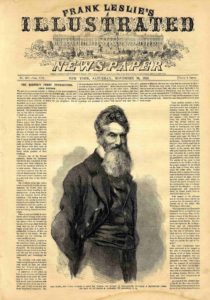On Oct. 16-18, 1859, radical abolitionist-prophet John Brown, leading six black and fifteen white disciples, seized the U.S. Arsenal at Harpers Ferry hoping to form a nearby, fortified and free, “State of Appalachia.”
“Captain” Brown’s idea was that blacks would rally to his cause, and the ensuing race war would spread across the South leading to the abolition of slavery in America.
While forty or more slaves recruited from nearby farms waited across the Potomac River, Brown’s plan to capture a trove of rifles went wrong when an insider tipped off authorities. Brown and seven of his men were surrounded and captured on the 18th by U.S. Marines acting under Col. Robert E. Lee. Stoically set to the end, Brown was hanged for treason on December 2, 1859.
Addressing the Virginia courtroom before receiving his sentence he proclaimed:
“Now, if it is deemed necessary that I should forfeit my life, for the furtherance of the ends of justice, and mingle my blood further with the blood of my children, and with the blood of millions in this slave country, whose rights are disregarded by wicked, cruel, and unjust enactments – I say, LET IT BE DONE!”
And handed to a guard before the hanging are his last words:
“I, John Brown, am now quite certain that the crimes of this guilty land can never be purged away but with blood.”
Whereas many historians cite Brown’s “calamitous invasion” of Virginia as starting the Civil War, it was abetted by wealthy northern abolitionists, the “Secret Six,” who funded his revolt that, in turn, fired public debate to fever pitch over sectional issues and secession – a near-scenario ex-President John Quincy Adams had once predicted, albeit privately.
Yet another of Brown’s backers was black business tycoon, Mary Ellen Pleasant, who from 1857-59, actively participated and donated $30,000 (equivalent to about $900,000 today). Brown was arrested with her note in his pocket signed “MEP,” but it was thought to read “WEP,” thus saving her a trip to the gallows. Frederick Douglass, also aware of the conspiracy, feared that his own incriminating correspondence with Brown would be discovered and quickly fled to Canada.
Brown achieved martyrdom, and when the Civil War began, a marching tune with a new refrain, “John Brown’s body lies a-mould’ring in the grave, But his soul is marching on,” dramatized the Union’s underlying cause. Although Julia Ward Howe rewrote the lyrics in 1861 as “The Battle Hymn of the Republic,” soldiers preferred the standard version and coined new verses as they marched South.


